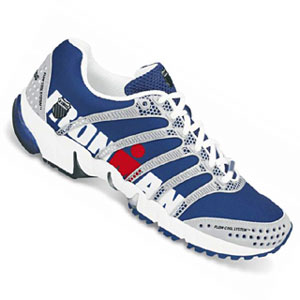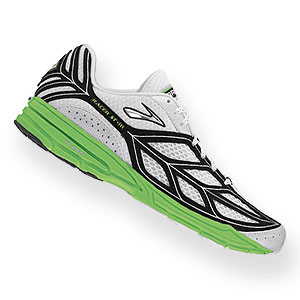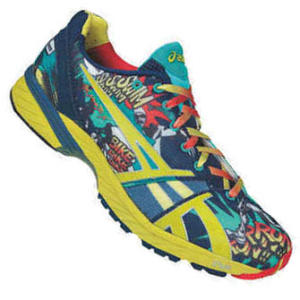
[Editor’s note: Our capable editor-at-large for footwear Jeroen van Geelen owns Total Running, one of the more important running and triathlon retail establishments in The Netherlands.]
Before I start with this third article on lightweight running I would like to mention that the technical specs of each shoe are based on its construction materials, user testing, comments from different athletes, and on manufacturer information.
I state this because of comments on prior articles I’ve written about shoes in this category from readers who are debating the amount of cushioning or stability, and so forth. The amount of cushioning in a shoe can be more than enough for one athlete yet for another, well, as I read in of the comments, “But it feels like a rock.”
This is a matter of personal taste, and you have to consider what you, personally, expect from a shoe. These articles are a guide to the different models you can expect this season, and the dividing line between Lightweight versus Racing versus other categories is arbitrary. Where I partition the categories might be different than where you draw these lines.
This is one reason why it’s useful—if you’re not certain what shoe you’re looking for—to buy your shoes at a specialty running store, where they can look at your old running shoes, perform a gait analysis, and where you can test in person the difference between models.
In this third article of lightweight running models I will review Newton, K-Swiss and Brooks (and if you expect to read about a model and you don't see it, it's because that model falls into a different classification that I admittedly, arbitrarily, choose; for example, the Brooks Adrenaline falls, according to me, into the stability category because of its substantive medial posting).

Newton Running
Distance and Distance S
The philosophy behind its running shoes is interesting and is completely different than the philosophy of other brands. Newtons are designed to create a sensation similar to that when running barefoot. Most humans strike on their midfoot/forefoot when running barefoot. Newton designed its shoes around this idea. Also, its Active Membrane Technology is designed as a propulsion device during the push off phase. If you want to read how the system functions it’s on Newton’s website.
But since most humans don’t run barefoot anymore it’s fair to question the utility of this system, and that’s where the debate lies. Personally, I would like to see athletes do more exercising barefoot so they strengthen their feet and low-leg connective tissue, but that’s outside the scope of this footwear overview.
The Newton Distance and the Distance S are the lightweight shoes from Newton. Newton calls these their racing flats, but due to the weight of these models—Distance 9.2 oz and the Distance S 9.5 oz—I put them in the lightweight category.
When you put the shoes on, the first thing you notice is that they look much lower in the heel than “normal” running shoes. This is of course due to the fact that the lugs under the forefoot are not yet compressed, as they would be during use. Standing in the shoes generates the sensation that you’re going to fall backward. For this reason I found these shoes not useful for heel strikers or athletes with a history of Achilles tendon problems.
But when you are a mid- to forefoot striker these shoes might be something to try. Are you going to run faster in Newtons than you would in shoes from another brand? I seriously doubt this, but overall I liked these shoes and, as a midfoot striker, they may work for me.
The difference between the Distance and the Distance S is that the “S” stands for stability and that means that the “S” model is more suited for athletes who overpronate; the Distance without the “S” is the neutral version.
Because Newton running shoes are not available in The Netherlands I must admit that this review is solely based on my personal experience, and from the recommendations of only two other runners. My one negative comment is that the Newton Distance series is very high in price ($155 for a pair of lightweight trainers is a lot of money—compared to the prices of shoes from other brands maybe a bit too high). Both models are available in specific men and women sizes.

K-Swiss
This brand is a newcomer to the running and triathlon market. Big in tennis and fashion, in running it is small. But since K-Swiss sponsors some world class triathletes (e.g., Chris Lieto) one assumes it’s serious about bringing out a first-class running collection.
It launched a few models last year, but they didn’t wow me in terms of design and function. Not that these were bad running shoes, but if you want to make an entrance in the running market as a new brand you either bring something new and special—as Newton did—or you make shoes to appeal to a niche market. K-Swiss went the latter route.
K-Ona
Last October at the Hawaiian Ironman K-Swiss launched its limited edition Ironman shoe, the K-Ona. There was a stars and stripes version with this design on its upper; another with the Australian flag; and one with the Ironman trademark.
My prediction: this last one is going to be the most successful. I think that K-Swiss has made a fine shoe, in the wearing of which you can make the statement you are a triathlete, no matter if you finished Hawaii or if you’re just dreaming of a finish one day.
The K-Ona mentioned above is the lightweight trainer in K-Swiss range (the "Ironman version" in the blue colorway heads this article; the white treatment is adjacent). The Hawaii debut was the limited edition launch; the shoes should be fully available in stores in a couple of weeks.
At just under 9 oz. they are lightweight. The upper is almost completely out of very breathable mesh which is supported by the K-Swiss 5 stripe trademark. These stripes are made from strong but flexible urethane and when laced up form snugly around your feet.
The midsole is made from an MEVA—K-Swiss calls this Superfoam technology—and offers more than enough cushioning for races up to marathon distance. To be honest, I was surprised how cushioned they felt. To create some torsional stiffness they added a midfoot shank. This model ought to be used by neutral runners or runners with a slight amount of pronation. Heavier runners should not choose this shoe, but they could use it as an après-triathlon shoe. Hey, were can you find a shoe with the Ironman logo that big on it?
Is there something missing in this shoe? In my opinion, yes. I think it’s a pity that K-Swiss didn’t offer this model with some more triathlon specific details, like an easy to pull on heel tab and a fast closure system, either in velcro like the Nike Kuakini a couple of years ago or with a system like the Zoot shoes have.
They do have waterholes in the midsole so water spilled at aid stations easily exits the shoes. In my opinion if you decide—as a brand—to make a shoe with “Ironman” written all over the upper you should make it a tri shoe in every detail.
But the overall job is very well done for such a relative newcomer to the market. I’m curious to see how they do on the counting list next Hawaii and as an après-triathlon shoe. I hear rumours about K-Swiss launching a complete triathlon apparel line as well, but I don’t think it will be for the Spring season; maybe they will launch this at Hawaii 09.
The K-Ona is available in a specific men's and women's versions.

Brooks
Ghost
Brooks made the Ghost with speed in mind but also with more protection than most models from other brands. Its cushioning is by far the best I’ve tested so far, but this affected the weight of the shoe significantly. At 11 oz. this is the “heaviest” lightweight trainer.
Despite the weight I put the shoe in this category because of the technical design of the shoe. It has a forefoot created to stimulate a faster push-off. The fit is snug and there is a slight midfoot shank. But this is not as rigid as in normal training shoes, so stability is limited. The midfoot and forefoot are pretty narrow, especially for Brooks, and they tend to fit a half to full size smaller then other Brooks models.
If you consider the weight it is not a specific lightweight trainer, but if you take a look at the technical design it is. Its excellent cushioning makes it suitable for the heavier athlete, and it’s a good shoe for anyone’s first lightweight trainer. The Ghost is made for athletes with a neutral- to underpronation footfall.

Racer ST
Brooks calls this shoe a racing flat, but considering the weight (8.7 oz.), I would say this is more a lightweight trainer. This shoe also runs more like a lightweight trainer. It’s more responsive, feels fast and is a shoe for those with a high leg turnover. The fit is a bit like the Ghost. I find the Ghost and the Racer ST a bit narrower then Brooks’ training shoes and more like the training shoes Brooks produces in narrower widths. But this is not a bad thing, just something to consider if you are a Brooks fan.
There's good cushioning in the heel and forefoot. The midfoot shank is only placed on the medial side of the shoe and, as in the Ghost, it’s pliable so it gives minor stability.
If you are an athlete with very neutral gait it might be that the Brooks DRB (Diagonal Rollbar) is too much for you and pushes your feet too much to the lateral side. If you can handle the weight and cushioning (or I might say the lack of it) of the T5 Racer this is more your shoe (and Chrissie Wellington’s). But this is a real racing flat. For slight to moderate pronaters the Racer ST is a pretty solid shoe in this category.
The Ghost is available in men's and women's version while the Racer ST is only a men’s version. Women should buy the men's size about 1½ size smaller then normal women sizes.
[If you like what Jeroen has written for our Slowtwitch readers, and if the Netherlands is a convenient country from which to buy, most of these shoes can be purchased at Jeroen's click and mortar store: Total Running.]


